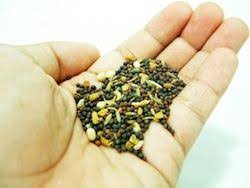Hari Om
Each 'Choose-day' we will investigate the process by which we can reassess our activity and interaction with the world of plurality and become more congruent within our personality.
We are reading the small booklet called "Not Too Loose, Not Too tight - Just right!" This is written by Swamini Vimalananda, and gives a very general overview of Vedanta for the beginner, with emphasis on the sattvic, rajasic and tamasic approaches to life. Remember, we are a mixture of all; use this as your mirror.
गति /gati - results (hereafter)
Every action has an equal and opposite reaction... 'as we sow, so we reap.' The results of mental, verbal, or physical actions are;
a) the joy or sorrow that we experience while doing the action
b) the impression, good or bad, which it leaves within us (vaasana)
c) the outer results that we get in terms of circumstances, which fructify in their own time. Some results of action are immediate whilst others may not come till some time later by weeks, months or years... still others may take life times to be exacted upon us.
 During our lifetime, we enjoy or suffer the consequences of all actions done in our past, be it within this life or any of our past lives. All actions create vaasanas in our minds. At the time of death, the predominant vaasanas from this and earlier lives are drawn together to determine the quality and 'texture' of future incarnations; the vaasanas also determine the type of body and the field of experience we shall obtain hereafter.
During our lifetime, we enjoy or suffer the consequences of all actions done in our past, be it within this life or any of our past lives. All actions create vaasanas in our minds. At the time of death, the predominant vaasanas from this and earlier lives are drawn together to determine the quality and 'texture' of future incarnations; the vaasanas also determine the type of body and the field of experience we shall obtain hereafter.
Sattvic; at the time of death a predominantly sattvic mind goes on to gain the highly subtle body of a presiding deity and enjoys subtle fields of experience... or he may be born as a human being and enjoy a high standard of living or gain a sattvic environment in which to fulfill the sattvic vaasanas brought into life.
Rajasic; a predominantly rajasic mind at the time of death gets to manifest as a human being in an action-oriented environment where he can exhaust his vaasanas of indulgence and activity.
Tamasic; a person with predminantly tamasic vaasanas at the time of death manifests as a human being in an inert or poor environment, or as some form of animal or plant; there he can exhaust his vaasanas of inertia and live in a state of non-thinking.

गति /gati - results (hereafter)
Every action has an equal and opposite reaction... 'as we sow, so we reap.' The results of mental, verbal, or physical actions are;
a) the joy or sorrow that we experience while doing the action
b) the impression, good or bad, which it leaves within us (vaasana)
c) the outer results that we get in terms of circumstances, which fructify in their own time. Some results of action are immediate whilst others may not come till some time later by weeks, months or years... still others may take life times to be exacted upon us.
Sattvic; at the time of death a predominantly sattvic mind goes on to gain the highly subtle body of a presiding deity and enjoys subtle fields of experience... or he may be born as a human being and enjoy a high standard of living or gain a sattvic environment in which to fulfill the sattvic vaasanas brought into life.
Rajasic; a predominantly rajasic mind at the time of death gets to manifest as a human being in an action-oriented environment where he can exhaust his vaasanas of indulgence and activity.
Tamasic; a person with predminantly tamasic vaasanas at the time of death manifests as a human being in an inert or poor environment, or as some form of animal or plant; there he can exhaust his vaasanas of inertia and live in a state of non-thinking.
